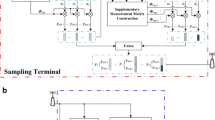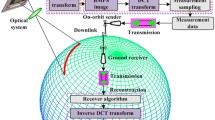Abstract
Compressive sensing can obtain high-quality image reconstruction at a lower sampling rate. Using image saliency for compressive sensing measurement and reconstruction can effectively improve the image quality of reconstruction. For this reason, we propose a method of saliency detection using compressive sensing global measurement values. This method uses the characteristics of the Hadamard matrix to reconstruct the original image with low resolution, and then uses the low resolution image for saliency detection. This method takes advantage of the feature that saliency detection does not require high-resolution images. At the same time, low-resolution images are also conducive to neural network reconstruction. Experimental results prove that low-resolution images can indeed obtain better saliency detection results. In order to further improve the saliency detection results, we also propose a saliency detection method with an adaptive measurement matrix. Experiments show that our method can obtain better reconstruction quality and saliency maps with a set of trained compressive sensing measurement matrices.





Similar content being viewed by others
References
Ghosh, S., Pramanik, A., & Maity, S. P. (2017). On far end saliency detection of images by compressive sensing (Vol. 322–334).
Donoho, D. L., et al. (2006). Compressed sensing. IEEE Transactions on Information Theory, 52(4), 1289–1306.
Candes, E. J. (2008). The restricted isometry property and its implications for compressed sensing. Comptes Rendus Mathematique, 346(9–10), 589–592.
Xie, X., Wang, Y., Shi, G., Wang, C., Du, J., & Han, X. (2017). Adaptive measurement network for CS image reconstruction. In CCF Chinese conference on computer vision (pp. 407–417).
Mousavi, A., Dasarathy, G., & Baraniuk, R.G. (2017). Deepcodec: Adaptive sensing and recovery via deep convolutional neural networks. arXiv preprint arXiv:1707.03386
Lohit, S., Kulkarni, K., Kerviche, R., Turaga, P. K., & Ashok, A. (2018). Convolutional neural networks for noniterative reconstruction of compressively sensed images. IEEE Transactions on Computational Imaging, 4(3), 326–340.
Zhang, Z., Liu, Y., Liu, J., Wen, F., & Zhu, C. (2020). AMP-Net: Denoising-based deep unfolding for compressive image sensing. IEEE Transactions on Image Processing, 30, 1487–1500.
Mdrafi, R., & Gurbuz, A. C. (2020). Joint learning of measurement matrix and signal reconstruction via deep learning. IEEE Transactions on Computational Imaging, 6, 818–829.
Cheng, M.-M., Mitra, N. J., Huang, X., Torr, P. H. S., & Hu, S.-M. (2014). Global contrast based salient region detection. IEEE Transactions on Pattern Analysis and Machine Intelligence, 37(3), 569–582.
Wang, W., Shen, J., Shao, L., et al. (2016). Correspondence driven saliency transfer. IEEE Transactions on Image Processing, 25(11), 5025–5034.
Guo, F., Wang, W., Shen, J., et al. (2017). Video saliency detection using object proposals. IEEE Transactions on Cybernetics, 48(11), 3159–3170.
Zhao, R., Ouyang, W., Li, H., et al. (2015). Saliency detection by multi-context deep learning. In Proceedings of the IEEE conference on computer vision and pattern recognition, (pp. 1265–1274).
Wu, Z., Su, L., & Huang, Q. (2019). Stacked cross refinement network for edge-aware salient object detection. In Proceedings of the IEEE/CVF international conference on computer vision, (pp. 7264–7273).
Wang, W., Lai, Q., Fu, H., Shen, J., Ling, H., & Yang, R. (2021). Salient object detection in the deep learning era: An in-depth survey. IEEE Transactions on Pattern Analysis and Machine Intelligence.
Yu, Y., Wang, B., & Zhang, L. (2010). Saliency-based compressive sampling for image signals. IEEE signal processing letters, 17(11), 973–976.
Zhang, X., Chen, J., Meng, H., & Tian, X. (2012). Self-adaptive structured image sensing. Optical Engineering, 51(12), 127001.
Li, R., Duan, X., Guo, X., He, W., & Lv, Y. (2017). Adaptive compressive sensing of images using spatial entropy. Computational Intelligence and Neuroscience, 2017, 1–9.
Zhou, S., Chen, Z., Zhong, Q., & Li, H. (2017). Block compressed sampling of image signals by saliency based adaptive partitioning. Multimedia Tools and Applications, 1–17.
Zhang, B., Liu, Y., Zhuang, J., Wang, K., & Cao, Y. (2019). Matrix permutation meets block compressed sensing. Journal of Visual Communication and Image Representation, 60, 69–78.
Zhou, S., Xiang, S., Liu, X., & Li, H. (2018). Asymmetric block based compressive sensing for image signals. In 2018 IEEE international conference on multimedia and expo (ICME) (pp. 1–6).
Zhao, Z., Xie, X., Wang, C., Mao, S., Liu, W., & Shi, G. (2019). ROI-CSNet: Compressive sensing network for ROI-aware image recovery. Signal Processing: Image Communication, 78, 113–124.
Mdrafi, R., & Gurbuz, A. C. (2017). Learning to detect salient objects with image-level supervision. In Proceedings of the IEEE conference on computer vision and pattern recognition (pp. 136–145).
Yan, Q. Xu, L. Shi, J. & Jia, J. (2013). Hierarchical saliency detection. In Proceedings of the IEEE conference on computer vision and pattern recognition (pp. 1155–1162).
Li, Y. Hou, X., Koch, C., Rehg, J. M., & Yuille, A. L. (2014). The secrets of salient object segmentation. In Proceedings of the IEEE conference on computer vision and pattern recognition (pp. 280–287).
Li, G., & Yu, Y. (2015). Visual saliency based on multiscale deep features. In Proceedings of the IEEE conference on computer vision and pattern recognition (pp. 5455–5463).
Yang, C., Zhang, L., Lu, H., Ruan, X., & Yang, M.-H. (2013). Saliency detection via graph-based manifold ranking. In Proceedings of the IEEE conference on computer vision and pattern recognition (pp. 3166–3173).
Cheng, M.-M., Mitra, N. J., Huang, X., & Hu, S.-M. (2014). Salientshape: Group saliency in image collections. The Visual Computer, 30(4), 443–453.
Funding
The funding was provided by the National Natural Science Foundation of China (62032022, 61972375, 61871258, 61671426) and Fundamental Research Funds for the Central Universities (E0E48980).
Author information
Authors and Affiliations
Corresponding author
Additional information
Publisher's Note
Springer Nature remains neutral with regard to jurisdictional claims in published maps and institutional affiliations.
Rights and permissions
About this article
Cite this article
Li, H., Lu, K., Xue, J. et al. Saliency Detection for Compressive Sensing Measurements. Sens Imaging 22, 43 (2021). https://doi.org/10.1007/s11220-021-00365-z
Received:
Revised:
Accepted:
Published:
DOI: https://doi.org/10.1007/s11220-021-00365-z




